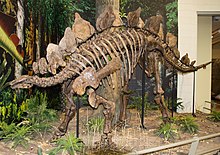Portal:Dinosaurs
IntroductionDinosaurs are a diverse group of reptiles of the clade Dinosauria. They first appeared during the Triassic period, between 243 and 233.23 million years ago (mya), although the exact origin and timing of the evolution of dinosaurs is a subject of active research. They became the dominant terrestrial vertebrates after the Triassic–Jurassic extinction event 201.3 mya and their dominance continued throughout the Jurassic and Cretaceous periods. The fossil record shows that birds are feathered dinosaurs, having evolved from earlier theropods during the Late Jurassic epoch, and are the only dinosaur lineage known to have survived the Cretaceous–Paleogene extinction event approximately 66 mya. Dinosaurs can therefore be divided into avian dinosaurs—birds—and the extinct non-avian dinosaurs, which are all dinosaurs other than birds. Dinosaurs are varied from taxonomic, morphological and ecological standpoints. Birds, at over 11,000 living species, are among the most diverse groups of vertebrates. Using fossil evidence, paleontologists have identified over 900 distinct genera and more than 1,000 different species of non-avian dinosaurs. Dinosaurs are represented on every continent by both extant species (birds) and fossil remains. Through the first half of the 20th century, before birds were recognized as dinosaurs, most of the scientific community believed dinosaurs to have been sluggish and cold-blooded. Most research conducted since the 1970s, however, has indicated that dinosaurs were active animals with elevated metabolisms and numerous adaptations for social interaction. Some were herbivorous, others carnivorous. Evidence suggests that all dinosaurs were egg-laying, and that nest-building was a trait shared by many dinosaurs, both avian and non-avian. (Full article...) Selected article
Allosaurus (meaning 'strange lizard') is a genus of large theropod dinosaur that lived 155 to 145 million years ago, in the late Jurassic period. The first remains that can definitely be ascribed to this genus were described in 1877 by Othniel Charles Marsh. As one of the first well-known theropod dinosaurs, it has long attracted attention outside of paleontological circles, and has been a lead dinosaur in several films and documentaries.
Allosaurus was a large bipedal predator with a large skull, equipped with dozens of large, sharp teeth. It averaged 8.5 meters (30 ft) in length, though fragmentary remains suggest it could have reached over 12 meters (39 ft). Relative to the large and powerful hindlimbs, its three-fingered forelimbs were small, and the body was balanced by a long, heavy tail. It is classified as an allosaurid, a type of carnosaurian theropod dinosaur. The genus has a complicated taxonomy, and includes an uncertain number of valid species, the best known of which is A. fragilis. The bulk of Allosaurus remains have come from North America's Morrison Formation, with material also from Portugal and possibly Tanzania. It was known for over half of the 20th century as Antrodemus, but study of the copious remains from the Cleveland-Lloyd Dinosaur Quarry brought the name Allosaurus back to prominence, and established it as one of the best-known dinosaurs. As the prominent large predator in the Morrison Formation, Allosaurus was at the top of the food chain, probably preying on contemporaneous large herbivorous dinosaurs. Potential prey included ornithopods, stegosaurids, and sauropods. While it is often thought of as preying on sauropod dinosaurs in groups, there is little evidence for cooperative social behavior in this genus, and individuals may have been aggressive toward each other instead. It may have attacked large prey by ambush, using its upper jaws like a hatchet. (see more...) TopicsSubcategoriesSelected image
Photo credit: User:Jack Mayer Wood Did you know...
Things you can do
Featured article candidates
Peer reviews
Articles to be merged
Articles to be split
Related content
Associated WikimediaThe following Wikimedia Foundation sister projects provide more on this subject:
Discover Wikipedia using portals |





























